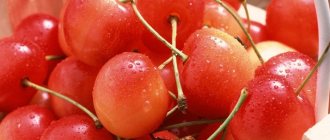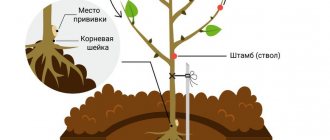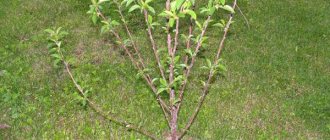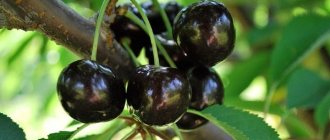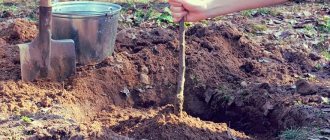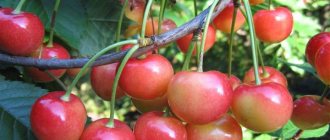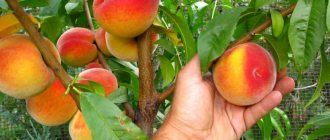History of the variety's creation
In the last quarter of the last century in the village. Michurinsky, Bryansk region, was the location of the All-Union Scientific Research Institute Lupin (later a branch of the scientific center “Federal Scientific Center for Forage Production and Agroecology named after V.R. Williams), whose specialists specialized in creating varieties of forage crops and breeding new types of horticultural crops.
As a result, this institute has more than 60 varieties of cherries, sweet cherries, currants, raspberries and apple trees bred by the institute’s specialists, including the Iput cherry, which was bred by specialists Kanshina M.V. and Astakhov A.A. in the last quarter of the past centuries. The bred variety was named after the river of the same name, which flows in the Bryansk region. In the 90s of the last century, Iput cherries were submitted for acceptance into the State Register of Russia, where they were included after tests in 1993.
Cherry Iput - photo
Cherry Iput: characteristics and description of the variety
Cherry Iput is a tree with a medium-sized central trunk and a wide crown, the height of an adult tree is about 3.5 m
, sometimes it can grow up to 4-4.5 m. The crown shape is wide-pyramidal. The color of the smooth trunk bark is brown with a reddish tint.
The shoots extend from the main trunk at an acute angle, are well leafy, with reddish-brown bark. The foliage is of medium length (up to 8 cm) and about 5 cm wide, ovoid, matte, slightly curved, without pubescence.
Berries are large in size, weighing up to 9 g
, dark red, almost black. The skin is smooth, shiny, thin, and practically undetectable in food. The pulp is slightly compacted, red, quite juicy, sweet, with a slight bitterness. The seeds in the berries are small in size; in ripe fruits they are difficult to separate from the pulp.
On a note!
Tasting assessment of Iput cherry fruits – 4 points out of 5 possible. The amount of sugars in ripe berries is 11.6, the amount of acids is small, no more than 0.7%.
The harvested crop withstands transportation well. But if the fruits on the tree are cracked, then it will not tolerate transportation well even over a short distance.
The collected fruits of this cherry are universally used; they are eaten fresh and can also be preserved. Cherry berries of the Iput variety make delicious jam, jam or compotes.
Photo of Iput cherry
It should be noted that ripe Iput cherry fruits contain a large amount of vitamin C, which makes these fruits very beneficial for the human body.
The frost resistance of this fruit tree is quite high, because the Iput cherry can tolerate cold temperatures down to -30 degrees Celsius
, and there is no damage to the shoots and trunk. However, warming, which then gives way to frost, is detrimental to this cherry. In this case, even a cold of -20 degrees, which comes after warming, will destroy this fruit tree.
The drought resistance of the cherry variety Iput is high.
– even if the drought period is long, you should not water this tree more than once every 6-8 days. Excess moisture is primarily detrimental to ripening berries - they immediately begin to crack.
Landing rules
Choosing a place to plant How to properly and most importantly where to plant cherries. Areas with groundwater are not very suitable for planting cherries . The permissible value is 1.5-2 m. High acidity of cherry soil is contraindicated. For the tree, it is important that the area is not exposed to strong wind loads and is illuminated from all sides.
If it is possible to plant a tree on the south side and closer to the building, this is a good option. A wall heated by the sun will protect from cold northern winds and give off heat. Planting in damp areas is allowed, but taking into account agricultural technology. It is necessary to plant on a hill and create a drainage system. Clay and sandy loam soils are the most favorable for the growth of cherries.
Landing algorithm
When planting, the root is not shortened in order to avoid long survival times. The rod itself is trimmed to 1 meter in height. Seedlings are planted before buds open in early spring . In the fall, it is not recommended to compress stone fruits in the middle zone. Poor survival rate, they do not have time to take root before the winter cold.
It is better to prepare the planting hole in the fall so that it shrinks and subsequently so that the root collar does not end up below the soil surface. It should always be 5cm above the ground. Dig 80 cm deep and about 50 cm wide. Place humus or organic matter at the bottom. You can add 30 g superphosphate and 20 g potassium chloride. In the 2-3rd year of planting, pruning is carried out: skeletal branches, lower branches are removed and the crown is thinned, at the same time the leader is shortened and transferred to the side branches to form a trunk.
Selection and preparation of planting material
A good seedling is characterized by a well-developed main stem with a large number of small hairs. Cherries are characterized by a horizontal type of root system. Thanks to fertile soil, fertilizing and watering, a horizontal root will begin to form in the second year of the seedling’s life.
It is difficult to dig up 2-year-old seedlings for sale without damaging the roots, therefore nurseries mainly sell annual ones, since the root system of cherries is powerful with well-developed branches. The annual tree reaches one and a half meters in height, has 3-4 shoots and many lobe roots.
It happens that a seedling does not have root branches, and there is only one stem, then such a seedling is not considered defective, do not be afraid to purchase it, it is important to simply shorten the main stem by 20 cm above the bud, thereby cutting off the crown. There should be no leaves or loose buds , as well as traces of lichens, broken branches, pests, and signs of disease.
Productivity of the cherry variety Iput
Fruiting of this variety begins 5 years after planting the trees in a permanent place
. Cherries begin to bloom in the second decade of May, the berries begin to ripen in the last days of June, therefore the Iput cherry variety is classified as an early variety of cherries.
Cherry Iput - video
Fruiting is considered stable, harvests are harvested annually. From each mature Iput cherry you can collect up to 28-30 kg of ripe berries. But with good care and compliance with all agrotechnical measures, the yield of the variety can be almost doubled. When growing this cherry on an industrial scale, up to 103-105 centners of ripe berries are collected from one hectare.
Reviews on forums
Iput turned out to be the most delicious and largest, bearing fruit in the 3rd year.
It grows very quickly, this year the growth is almost a meter high. Our Iput is not dark red, but simply red, maybe it doesn’t have enough sun. GRUNYA
https://dacha.wcb.ru/lofiversion/index.php?t22817.html
From successful cultivation and good fruiting, I currently know Iput and Revna, they are planted together, since cherries are self-sterile, and these varieties are mutually pollinating.
But even the perfectly growing, frost-free and fruit-bearing cherry tree has a big disadvantage - it grows as a tall thin tree (it’s problematic to lean a ladder against it), which means it needs shaping. stounns
https://www.tomat-pomidor.com/newforum/index.php?topic=2109.0
Cherry Iput feels good in central Russia due to its good winter hardiness. Cherry berries are large, sweet, suitable for preparing canned preparations. When growing this variety, do not forget that the tree needs pollinators for a good harvest.
Pollinator trees for cherries Iput
The Iput cherry is a partially self-fertile variety, but to obtain high yields it is necessary to plant other cherry varieties with the same flowering periods close to the Iput.
The best “companions” or pollinating trees for Iput cherries can be:
- Tyutchevka;
- Veda;
- Bryanochka.
Experts recommend simultaneously planting Iput cherry seedlings and pollinating trees nearby.
As a result, these stone fruit trees will reach fruiting period at the same time and their yield will be high due to cross-pollination. Varieties of berries!
Cherry Fatezh Cherry Ovstuzhenka Cherry Leningradskaya black
Characteristic
Cherry Iput: description of the variety, photos, reviews give a complete idea of what the tree looks like and how to properly cultivate it in a summer cottage to obtain a consistently high yield.
General characteristics of the plant:
- Height. Cherry trees can grow approximately 5 m in height. The crown is wide, not too leafy, and looks like a pyramid. The stems are quite thick and straight, covered with gray bark on top, no pubescence.
- Foliage. Characterized by an oval shape with jagged edges, quite large. The foliage has wavy shapes and a dark green hue. The top of the leaf blade is elongated and pointed, with a round base. The surface of the plate is without pubescence and smooth. The buds are large in size and cone-shaped or oblong in shape.
- Flowers. Approximately 4 large flowers can form in inflorescences. The petals are mostly white and have a narrow cup. The buds begin to bloom in the month of May. The petioles are characterized by their short length. The berries ripen on bouquet branches.
- Fruit. They are large in size and have an average weight of approximately 6 g. Cherry berries are one-dimensional and heart-shaped. The apex of the fruit is round, with a narrow funnel. Berries that are at the ripening stage have a dark red hue. After final ripening, the fruits become black. Each berry has a light dot at the top. The side seam is very pronounced. The skin is shiny, and the stalks are thick and short.
- Bone. It has an ovoid shape with a round base and a pointed apex. It is very difficult to separate the pit from the edible part of the cherry.
- Taste qualities. The fruits have a sweetish taste. The soft part is moderately dense, juicy and dark red in color.
The garden crop begins to bear fruit after 5 years from the moment the seedling is planted in open ground. The harvest takes place annually and without interruption. The berries finally ripen by the middle of the summer season. However, if it rains regularly 3 weeks before harvest, the berries may crack. The fruits are of medium density and tolerate transportation well. But storing fresh harvest for a long time is not recommended.
Iput cherry has good frost resistance. In winter, the variety can withstand frosts reaching -35 degrees.
The drought resistance of the crop is at an average level. In the central regions of Russia, cherries need to be watered once a month. For an adult tree, the volume of water should reach approximately 60 liters. In the southern regions, spraying is required twice a month.
Advantages of the variety
Experts include the main positive qualities of the Iput cherry variety:
- high frost resistance;
- fruiting – annual, stable and high;
- fruit ripening period is early;
- good resistance to major diseases and pests;
- due to the small height of the trees, harvesting is not difficult;
- ripe berries have a universal purpose;
- good taste of ripe fruits.
Among the disadvantages of the variety, gardeners should pay attention to the following:
- late start of fruiting - 5 years must pass after planting Iput cherry trees before they begin to bear fruit;
- if excess water appears in the soil, the fruits may crack;
- The seeds in ripe fruits are too poorly separated from the pulp.
Harvest and storage
Cherries of the Iput variety are harvested at the end of June, beginning of July. The berries ripen at the same time, making harvesting easier.
To extend the shelf life of the berries, they are picked along with the stalks. This way the fruits remain whole and dry.
After picking, the berries are sorted and sorted. Whole fruits are placed in prepared containers and sent for storage in refrigerators. Damaged and soft berries are processed immediately.
At room temperature, cherries can be stored for no more than 3 days, in the bottom drawer of the refrigerator for up to 7 days. In specially equipped chambers, the berries retain their presentation for up to 3 weeks.
Advice! To enjoy the taste of ripe cherries longer, the berries are dried or frozen.
Planting Iput cherries - features and rules
When planting the Iput variety, other varieties of cherries should be planted nearby at the same time, so that by the time the cherries bear fruit, mature pollinating trees will grow nearby.
In the southern regions of Russia and regions with a mild climate, this variety of cherries can be planted in the spring and autumn months. Moreover, experts advise planting Iput cherries in the south in the fall, since when planted in the spring, young trees may suffer from sunburn and lack of moisture during the summer.
Important!
And in the northern regions, Iput cherries cannot be planted in the fall - the tree will not have time to take root well before winter and will die during severe frosts.
Another mandatory condition for planting seedlings is that they must be at rest - when planting in the spring before the buds swell, when planting in the fall - after the end of leaf fall.
Planting Iput cherries - video
In order for this variety to have consistently high fruiting in the future, when planting Iput cherries, the following conditions must be observed:
- Other fruit trees cannot be planted between cherry seedlings - they will interfere with cross-pollination of the cherry trees;
- the selected area should be sunny and protected from gusts of cold winds;
- Cherry trees should be planted in loamy or sandy loam soil with a neutral pH, loose and fairly fertile;
- groundwater should not approach the ground surface closer than 2 m;
- These fruit trees should not be planted in lowlands or in places where moisture can stagnate.
You should not plant apple, pear and plum trees near the Iput cherry tree.
. The best neighbors for this fruit tree will be other varieties of cherries or cherries; it is also good to plant a vineyard or black elderberry nearby, which repels aphids from neighboring trees.
The distance between adjacent planting pits is about 3 m. The diameter of the planting pits should be about 1 m and the depth - 80 cm. Then a nutrient substrate composed of garden soil, humus and superphosphate is laid out at the bottom of the pit.
A stake is dug near the center of the hole, to which the seedling will be tied after planting. The height of such a peg is at least 0.9 m. In the center of the hole, a mound is made from the ground, on which the seedling is placed, and its roots are distributed along the slopes of the hill. Then the hole is filled with soil, compacting it. The tree is tied to a support and at least 35 liters of water is poured into the circle around the trunk. A layer of mulch 4-5 cm thick is placed in the tree trunk circle; straw or rotted sawdust can be used as a mulching material.
Frost resistance and winter hardiness
Sweet cherries love warmth, so they are common in southern Europe - countries with a temperate climate. The middle zone is no exception for the new variety. This variety begins to bear fruit in the 4th year of life, of course, if there are favorable conditions for caring for the seedling.
Breeders have achieved stable indicators of frost resistance and winter hardiness of the Iput cherry. The standard and skeletal branches even after harsh winters are 0.6 points, showing greater resistance to sunburn and frost damage.
When the temperature drops to 3-5 C below zero during the flowering period, cherries are able to retain more than 60% of the pistils and more than 20% of the flower buds.
The plant world is diverse, but not all species are able to withstand harsh cold conditions. Winter hardiness is one of the criteria for choosing the viability of plants for a particular area. Biological organisms for growth in open ground must be selected taking into account frost resistance. And not only low temperatures indicate a threat to the existence of flora representatives.
Sudden changes in temperature, icing, drying out, damping off, prolonged thaws, freezing, soaking, sunburn, wind and snow loads, recurrent frosts after spring warming are unfavorable climatic conditions.
How seedlings react to this indicator of environmental aggressiveness is the plant’s winter hardiness or is it a myth.
The level of winter hardiness is not a constant value and varies depending on the location of the plants and their care.
Frost resistance is built into plant cells at the genetic level , and adaptability to adverse weather conditions is an indicator of the ability to withstand low temperatures. So, frost resistance in the bred variety remains unchanged , but it is possible to influence winter hardiness by taking certain measures.
Measures affecting the winter hardiness of the plant:
- Fertilizing with mineral fertilizers. Stable stamp.
- Tiered grafting.
- Pre-winter and pre-spring preparation.
How the trees lived in the summer directly depends on how they will enter the winter. If the summer was cloudy and rainy, then photosynthesis of the leaves was weak, the trees were severely damaged by scab, and were not hardened by the first frosts in the fall, then even a warm winter may be the last for the seedling .
But hot, dry summers are also not favorable for seedlings going into winter. With certain care, it is possible to increase winter hardiness. Apply fertilizer, whiten the trunk and large skeletal branches and water accordingly.
Fertilizing Iput cherries
Cherries should be fed several times a season:
- before flowering begins, ammonium nitrate is added to the tree trunk circles (for each square of area - 1 tbsp.);
- during active flowering, add urea, which is diluted in water - 40 g in 20 liters of water;
- During the formation of ovaries, chicken manure concentrate, diluted in water in a ratio of 4 liters of concentrate per 20 liters of water, is added to the tree trunk circles.
In summer, you can fertilize cherries leaf by leaf using a solution of monophosphate or nitrophoska.
In the fall, organic fertilizers are applied to each tree. Important!
Every year you should feed only young Iput cherries up to 7 years of age. Then fertilizing is applied once every 3 seasons.
Diseases and pests of varieties and measures to combat them
The Iput cherry harvest directly depends on the health of the tree. It is necessary to monitor the condition of the bark and leaves, and inspect the trees for pests.
- In March, it is recommended to spray cherries with preparations that will protect against cherry flies and moths. These are Nexion, Chlorophos, Karbofos solution. Spraying is carried out until the buds swell.
- For lacewing and bud mite, once a month trees are sprayed with fungicides Antiklesch, Tsifoks, and Karbofos solution.
- After flowering, the trees are affected by the cherry sawfly, fly, goose, stalk, and aphids. Insecticidal preparations Fufanon, Metafos, Trichlorometaphos-3, Aktelik will help cope with harmful insects. This procedure is carried out twice a month.
- After harvesting, trees are subject to rodent infestation. They will be scared away by sawdust soaked in kerosene, scattered in the tree trunk circle. Another control measure will be regular loosening of the soil around the trunk.
Iput cherry is resistant to viral diseases of fruit trees. When there is a lot of rain, it is damaged by rust, clasterosporiosis and coccomycosis.
- If brown spots appear on the green leaves of the cherry tree, this is rust. Infected leaves should be torn off and burned. Prevention will be by spraying the leaves with a 1% solution of Bordeaux mixture.
- Hole spot (klyasterosporiosis) appears on the leaves in the form of dark spots, which grow over the surface of the leaf and form holes. A preventative control method will be to treat the tree with a solution of copper sulfate before and after the tree blooms. Infected leaves should be torn off and burned.
- Coccomiosis is manifested by the appearance of a purple tint on the foliage, which quickly dries out. To prevent the disease, it is recommended to treat in early spring and after harvesting with a solution of Bordeaux mixture or copper oxychloride.
Cherry Iput: pruning rules
The further abundant fruiting of the tree depends on the correct formation of the crown of the Iput cherry tree in the first years.
Therefore, it is recommended to carry out formative pruning of the Iput variety in the following way:
- Iput cherries are pruned for the first time in the second season after planting. The first tier of the tree is formed at a distance of 50-60 cm from the ground, leaving no more than 4 skeletal branches. All other branches are cut in half or removed completely;
- next year, a second tier is formed, and at a distance of 50 cm from the first, all shoots are cut out, leaving only two branches;
- next spring, 1 branch is left in the third tier, the main trunk is cut off;
- in subsequent years, all shoots are shortened by half.
How to prune cherries correctly - video
Sanitary pruning is also carried out annually, removing all dried, damaged or diseased branches, as well as shoots growing incorrectly or thickening the crown.
Features of care
Proper care is the key to health and a good cherry harvest. By performing simple and regular actions, you will protect the tree from diseases and pests, help it survive the winter and increase the volume of the harvest.
Trimming
Cherry Iput grows into a tall, large tree. Without proper crown formation, caring for it and collecting fruits will be very problematic. To solve these problems, the tree undergoes several types of pruning. Crown-forming pruning is performed in the first 4 years of tree growth; sanitary pruning is also necessary, and mature trees sometimes need to undergo rejuvenating pruning. Since the crown of Iput is moderately thick, the problem of thinning is not too acute. Nevertheless, it is worth considering this point and, with each pruning, think about lightening the crown.
It is better to choose a loose-tiered pruning scheme for Iput cherries. It involves the formation of several main tiers of branches in a tree. For correct pruning, you should adhere to the following scheme:
- In the second year of tree growth, form the first tier of branches. The branches of the tier should be located at approximately the same height (the distance between them should not exceed 10 cm). Choose 3-4 branches pointing in different directions. Competing branches of the tier should be removed, and the remaining ones should be trimmed by 20–25%. The main shoot is shortened by 20–25 cm.
- In the third year, the tree is formed with a second tier of 2–3 branches. It should be located 45–50 cm above the first tier. Competing branches of the tier are also removed, the branches of the second tier are shortened by 20%, and the branches of the first tier are cut so that they are 25 cm longer than the branches of the second tier. The main shoot is shortened by 15–20 cm. If there are branches between the tiers, they are shortened by 40%.
- In the fourth year of tree growth, the third and final tier of the crown is formed from 1–2 branches 50 cm above the second tier. Competing branches are also removed, the branches of the third tier are cut by 20% and the main shoot is shortened to the same level. The branches of the second tier are cut so that they are 20–25 cm longer than the branches of the upper tier.
At this point, the formation of the crown can be considered complete. Next, every year they make sure that the branches do not grow inside the tree and do not thicken the crown. Crown-forming and thinning pruning is carried out in the spring before the buds open. In this case, the branches are cut to the outer bud, that is, a cut is made above the bud that is turned toward the outer part of the crown, so that subsequent branches grow outward from the center of the tree.
Rejuvenating tree pruning is carried out every 10–15 years. At the same time, cherries are pruned into three-year-old wood. If the crown is very thick, you can also trim the main conductor by 40–60 cm. This will lighten the tree and rejuvenate it.
In the fall, 4–5 weeks before the onset of frost, the tree undergoes sanitary pruning. At the same time, all dried, diseased and deformed branches are removed. It is important to take into account the timing of frost so that the cherries have time to recover after pruning.
Trees need to be pruned in spring and autumn.
All tree trimming operations should be carried out with disinfected and sharp tools to avoid contamination of the tree, and after cutting, use garden varnish or cover them with 3-4 layers of oil paint.
Watering
Watering is especially important for young trees. In the first year of growth, cherries are watered every week with 10–15 liters of water to promote rooting of the plant. From the second to the fourth year of growth, cherries are watered every 2–3 weeks with 15–20 liters. An adult tree is watered 3-4 times a year: before flowering, immediately after flowering, after harvesting and in the fall, 30-40 liters each, taking into account weather conditions.
Young trees especially need regular watering
In the fall, water-recharging irrigation is carried out for cherries, spilling 50–60 liters of water on each square meter of the tree trunk circle. This procedure helps the tree strengthen its root system and more easily survive winter frosts. It is best to carry out irrigation using the sprinkling method or to form 3 watering grooves in the crown projection, each 7–9 cm deep, radially located from the cherry trunk at 60, 100 cm and 140 cm, respectively. After watering, as well as after natural precipitation, the ground under the tree must be loosened and mulched with straw or peat.
Crop protection
An important point in caring for cherries is protecting the harvest from birds. To do this, you can use special nets that cover the tree and prevent feathered pests. In addition, you can place sound repellers around the area or try to deal with birds using plastic bags and foil, attaching them to a tree.
The mesh on the cherry prevents birds from pecking the berries
Tree fertilizer
For stable fruiting, the cherry tree needs regular fertilizers. In the first year after planting, young cherries are not fertilized, since all the necessary substances were placed in the planting hole. Young trees from the second to the fifth year of growth are fertilized before flowering with ammonium nitrate for digging, 15 grams per square meter of area in the projection of the crown and 10 grams of urea per 20 liters of water in May after flowering. For mature trees, the dose of mineral fertilizers is doubled.
Mineral fertilizers allow cherries to produce a bountiful harvest
Cherries also need organic fertilizers. They are laid in the fall during the second and fourth years of tree growth, and then every 3 years. To apply fertilizer, grooves 7–9 cm deep and 15 cm wide are formed in the crown projections, into which 15–20 kg of manure (biennial), 20–30 kg of compost or humus are placed, or a stock solution of chicken manure is poured. To prepare a mother solution for a young tree, take 1 kg of dry droppings per 7 liters of water and infuse for 5 days, and then further dilute with 15 liters of water. For an adult tree, you should take 3 kg of droppings. The fertilizers placed in the grooves are sprinkled with earth on top. This method of application ensures a uniform supply of nutrients to the tree and also protects the roots from burns.
Preparing for winter
Although Iput is a winter-hardy cherry variety, the tree needs to be prepared for the winter season. This preparation is especially important for young trees. To overwinter cherries, perform the following operations:
- The tree trunk circle is cleared of leaves, branches, weeds and grass, and then dug up to destroy pests hibernating in the ground.
- The tree trunk and 30% of the branches of the lower tier are whitened with a solution of 150 grams of copper sulfate, 0.5 kg of lime and 1 kg of powdered clay, diluting the components in 15 liters of water for young trees and 7 liters for adults. This difference in concentration is important so as not to burn the trunk of young trees. This operation protects the tree from diseases, pests and rodents, and also prevents sunburn in the spring.
- The tree trunk circle is mulched with peat or sawdust to a depth of 15–20 cm, and in the spring, when the night temperature is positive, the layer of mulch must be removed to avoid rotting of the roots.
- Trees can be additionally insulated with spruce branches.
Whitewashing is an important stage of care for maintaining the health of cherries.
A tree properly prepared for winter will be protected from frost and pests, so it will wake up faster in the spring and produce a better and more abundant harvest.


